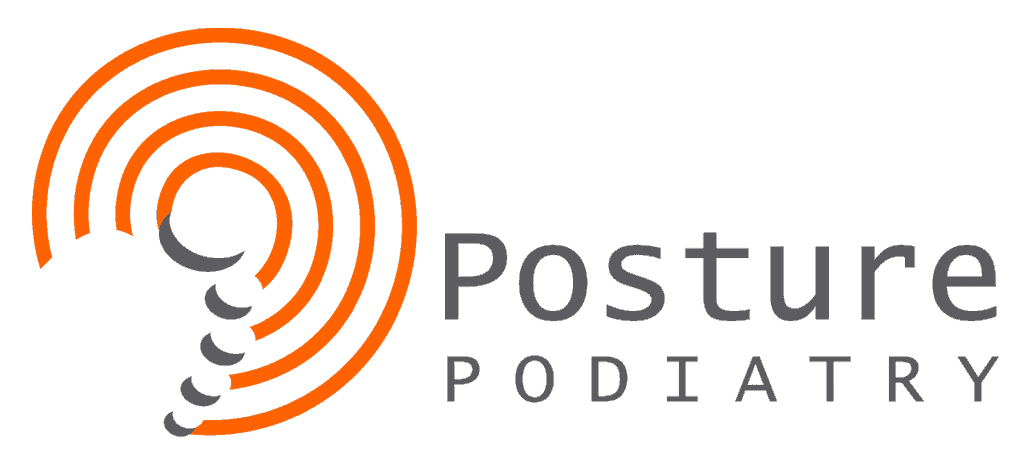Plantar Fasciitis can be a painful and debilitating condition, but there are ways to ease the pain! Our Adelaide Podiatrists have developed the ultimate guide and answered the most common questions including heel pain treatment options and preventative tips.
What is Plantar Fasciitis?
Plantar fasciitis is a common foot condition that can often cause pain in the heel and bottom of the foot. The term plantar fasciitis means inflammation of your plantar fascia. Plantar fasciitis occurs due to inflammation of the plantar fascia, a thick band of tissue that runs along the bottom of your foot from your heel bone to the ball of the foot and through to your toes.
It’s a very strong ligament, so problems usually occur beneath the heel at the attachment to the heel bone.
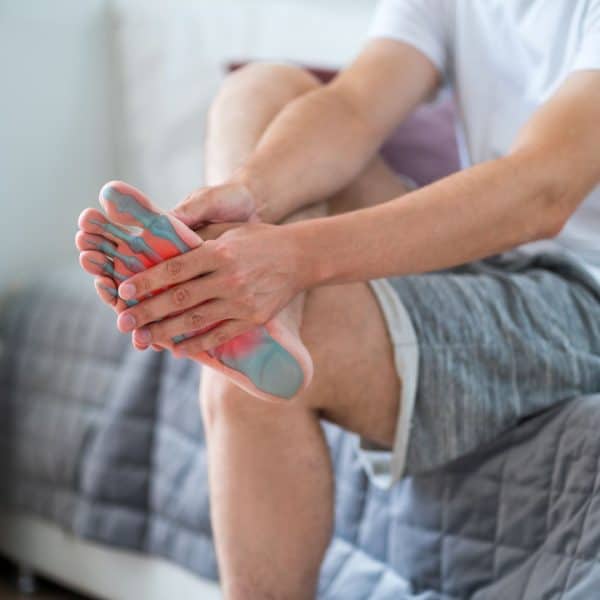
What Causes Heel Pain in The Morning?
People with plantar fasciitis often complain of heel pain, and it’s usually reported as being worse in the morning or after sitting or simply resting for a while. The reason for the severe pain when arising from rest is thought to be the result of micro-tearing of scar tissue when you first place load on the plantar fascia.
The plantar fascial ligament will undergo a process called fibrosis (or scar tissue formation) when at rest. When a person with a healing plantar fascia arises from rest, the scar tissue is then torn which causes pain with the first few steps. The tearing often occurs at the origin of the plantar fascia just beneath the heel bone.
Eventually, the pain eases after 8 to 10 steps because the tearing of the plantar fascia reduces with each step. If a person continues to stand and walk for long periods throughout the day, the pain will usually return. In summary, the heel pain in the morning is caused by microscopic tearing of the scar tissue which forms in an effort by the body to heal the plantar fascia.
Looking for an Adelaide Podiatrist for plantar fasciitis heel pain treatment?
BOOK ONLINE for an Initial Low or No Gap* Assessment
by experienced Adelaide Podiatrists or
Call 8362 5900 to schedule a Low or No Gap* examination to see if we can help.
What does the Plantar Fascia feel like?
You can easily feel your own plantar fascia. Just run your finger along the arch of your foot. You’ll feel that rope-like connective tissue that pops out when you pull your toes back. That’s your plantar fascia… and it’s really important.
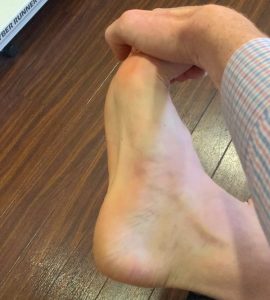
When you’re walking, your plantar fascia stabilises your arch to enable you to push off properly. It’s the longest ligament in the body – and the strongest as well, able to withstand up to 30 times your body weight.
Technically, the chronic heel pain problem is actually more often to do with degeneration of the plantar fascia. That’s why podiatrists can refer to it as plantar fasciosis. However, we’ll use the more popular term, plantar fasciitis here.
People with plantar fasciitis usually complain of heel pain in the morning or after rest. Share on X
Plantar Fasciitis is a common diagnosis for anything heel pain-related, but can be mis-diagnosed in up to 80% of cases. It’s important to get the right diagnosis to ensure you receive the most effective heel pain treatment.
Looking for an Adelaide Podiatrist for plantar fasciitis heel pain treatment?
BOOK ONLINE for an Initial Low or No Gap* Assessment
by experienced Adelaide Podiatrists or
Call 8362 5900 to schedule a Low or No Gap* examination to see if we can help.
What are the symptoms of Plantar Fasciitis?
You can feel a sharp pain when you are on your feet, and a dull ache when you’re resting, but usually it is worse in the morning when you are hobbling, or after you’ve been sitting down for a while. The most common symptom of plantar fasciitis is sharp, stabbing pain in the heel, especially with the first few steps in the morning or after periods of rest. The pain may also worsen after prolonged activity or standing.
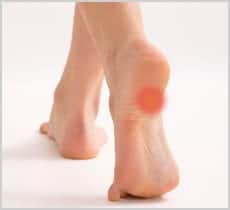
It will usually hurt most intensely directly underneath the heel bone right in the centre of the pad of your heel. However, this is not always the case. Sometimes the pain will run along the length of the plantar fascial ligament or it may feel like foot pain to the side of the heel or the foot.
How is Plantar Fasciitis Diagnosed?
Plantar fasciitis is typically diagnosed based on a physical examination and a discussion of symptoms. Additional tests, such as X-rays, Ultrasound scans or an MRI, may be ordered to rule out other possible causes of heel pain.
What Causes Plantar Fasciitis?
Inflammation of the plantar fascia can occur for many reasons. Plantar fasciitis is commonly caused by excessive strain, load or repetitive stress on the plantar fascia. The plantar fascial ligament is the largest band of fibrous tissue which supports the longitudinal arch of the foot. If the load on this band of tissue becomes too great, microscopic damage and tearing will commence. This is usually the case with high impact activities involving running and jumping but damage and tearing can also occur in older people. In fact, a recent study found individuals aged over 50 years can be more susceptible to plantar heel pain.
People with flatter feet, high arches and tight calf muscles may also be more susceptible to plantar fasciitis. Sudden overuse injuries, new shoes, doing more activity than normal, or perhaps just standing for longer periods than normal can all cause micro-tearing of the plantar fascia. The extra load pulls the plantar fascia from the heel bone and starts the process of inflammation and scar tissue formation.

Usually this damage will heal if you are off your feet for a while, for example, while sleeping overnight. The body heals the painful area with fibrosis or scar tissue formation. However if your foot isn’t getting a chance to rest properly, the new tissue can be damaged again as soon as you stand on the feet after rest.
This starts the injury cycle of pain and micro-tearing all over again. That’s why plantar fasciitis often hurts most after you’ve been resting for a while.
Looking for an Adelaide Podiatrist for plantar fasciitis heel pain treatment?
BOOK ONLINE for an Initial Low or No Gap* Assessment
by experienced Adelaide Podiatrists or
Call 8362 5900 to schedule a Low or No Gap* examination to see if we can help.
Over time the plantar fascial ligament tissue starts to thicken and if inflammation continues, standing can become very painful. The body is clever, though, and if you let it go too long it will grow extra bone. This is the beginning of a heel spur.
If you let plantar fasciitis go, you can develop a heel spur. Surprisingly, the spur is rarely the cause of pain. The inflammation near the heel spur is often the problem Share on X
Are some people more likely to get Plantar Fasciitis?
People who have recently changed jobs or started on a health kick can be more likely to get plantar fasciitis, and it’s not limited by age. More often, though, it’s middle-aged women and men that get it.
Some people who have injured themselves in the past can be more prone to plantar fasciitis as the body tries to compensate for the injury.
Generally, if the plantar fascial ligament is continually overused or overloaded through activity or structural problems in the feet and legs, then injury is more likely.
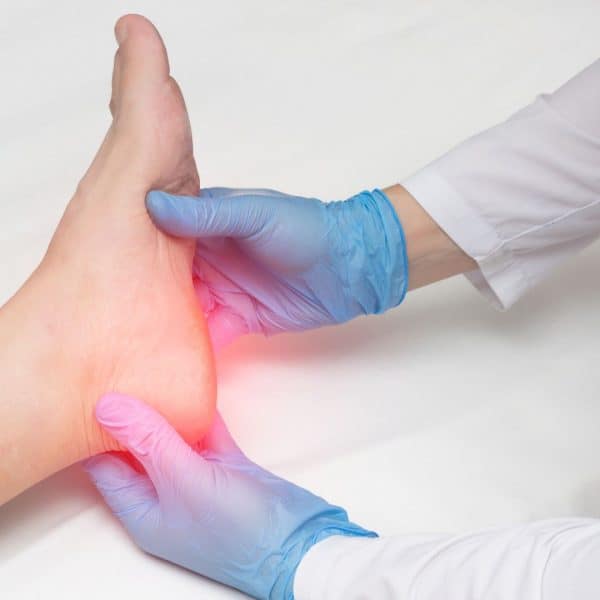
It’s actually quite amazing how our feet endure what we put them through. In a lifetime we will walk the equivalent distance to walking around the earth 3 times. There will be natural degeneration and weakening depending on your activity levels and injury history that might also contribute to getting plantar fasciitis.
In a lifetime we will walk the equivalent distance to walking around the earth 3 times Share on XIf you have plantar fasciitis, are there exercises you should avoid?
If you have plantar fasciitis, make sure you’re giving it a chance to heal. Long runs on hard ground, beach sprints that require bursts of power, jumping and lunging can all make it worse in the initial stages. You want to give it a chance to heal without damaging things further. As healing takes place, progressive loading will commence to regain strength in the structures which support the plantar fascia.
You need to find a balance between giving it enough rest to heal, and enough work to stay strong. That’s the tricky part, but if you get it right you can recover well enough to return to normal mobility.
What are the best exercises for plantar fasciitis?
Every person needs to be assessed as an individual but, in many cases of plantar fasciitis, the simplest and easiest stretching exercise we advise is a gentle, prolonged stretch of the calf muscle complex and plantar fascia. This is usually performed best in a prone position (i.e. laying on the tummy) with the toes and ankles extended as displayed in the image below. Be careful though… it’s crucial this stretch is performed correctly as prescribed and it can cause some discomfort if you have a condition called ‘Hallux Limitus’ or ‘Hallux Rigidus’ so it’s important to consult your Podiatrist before performing this exercise.
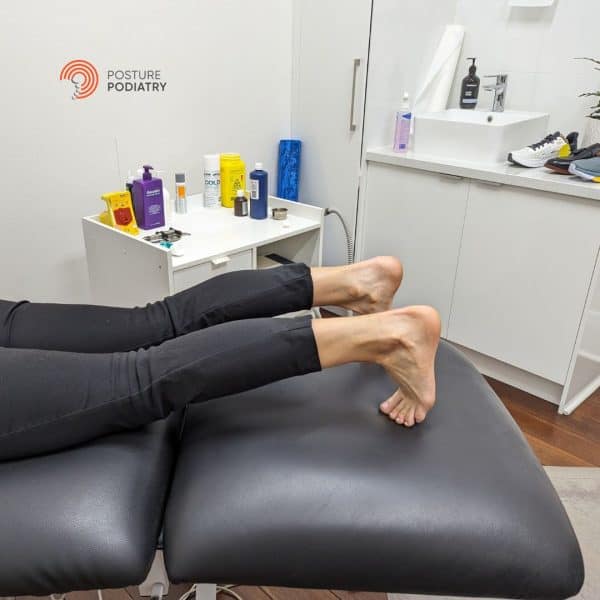
The above exercise is just the starting point for exercise prescription and management. Further strengthening and stretching exercises are then prescribed over a 12 week period. These strengthening and stretching exercises are personalised to each individual’s needs and will change according to the severity of plantar fasciitis and the stage of heel pain treatment.
Exercises for plantar fasciitis can be very helpful as part of the overall management program but they are not a ‘magic cure’ for the problem.
What are the best shoes for plantar fasciitis?
You’ll feel better and more comfortable with cushioning or padding under your heels. Firm, hard soled shoes will be much less comfortable than cushioned walking shoes or sneakers. But again you need to have a balance between something soft, and having enough support. So, wear comfortable, supportive shoes, and make sure you stretch every day.
It can also help to massage the area by rolling your foot over a tennis ball or golf ball. If pain persists, see an experienced podiatrist.
Looking for an Adelaide Podiatrist for plantar fasciitis heel pain treatment?
BOOK ONLINE for an Initial Low or No Gap* Assessment
by experienced Adelaide Podiatrists or
Call 8362 5900 to schedule a Low or No Gap* examination to see if we can help.
What is the best treatment for plantar fasciitis?
Podiatrists are the health professionals dedicated to problems involving the feet, and have expert knowledge and training for helping people with plantar fasciitis. Plantar fasciitis treatment and management is something the podiatrists at Posture Podiatry have a special interest in. Successful treatment usually includes a combination of the following. Your podiatrist can:
- Order an X-ray and/or ultrasound scan to find out exactly what’s wrong
- Help you find the right shoes to wear
- Advise on appropriate plantar fasciitis socks
- Help you with specific plantar fasciitis exercises for your feet
- Help your muscles and joints work together with foot mobilisation to encourage healing
- Make specific orthotics for your shoes to offload the painful area and promote healing of the injured plantar fascia
- Assist with taping and plantar fasciitis strapping techniques to support the injured area
- Advise on appropriate night bracing if needed
- Help with shock wave therapy (ESWT) in chronic heel pain cases
- Advise on activity or training modification
- Work with you to make sure the problem doesn’t return
Everything is focused on treating the cause of the problem, and reducing the load on the plantar fascia. That’s how you can speed up healing and prevent the problem returning.
Once your pain has resolved, progressive loading can commence with a major focus on specific strengthening exercises, support and prevention of injury recurrence.
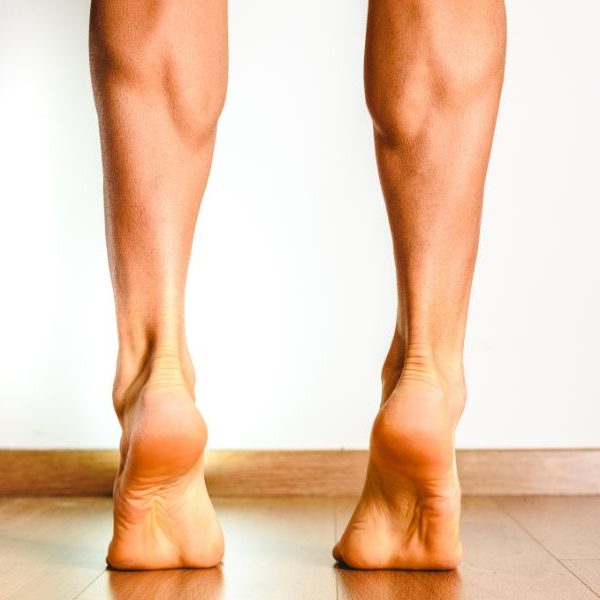
Looking for an Adelaide Podiatrist for plantar fasciitis heel pain treatment?
BOOK ONLINE for an Initial Low or No Gap* Assessment
by experienced Adelaide Podiatrists or
Call 8362 5900 to schedule a Low or No Gap* examination to see if we can help.
Is rest necessary for treating plantar fasciitis?
Complete rest is rarely necessary, however, controlled rest or activity reduction is sometimes an important part of treating plantar fasciitis. It helps reduce inflammation and allows the plantar fascia to commence healing. Activities that aggravate the condition should be avoided or modified accordingly.
Are there any exercises or stretches that can help with plantar fasciitis?
Yes, there are several exercises and stretches that can help relieve symptoms of plantar fasciitis. These include calf stretches, plantar fascia stretches and strengthening exercises for the foot and ankle. Perfoming the correct stretches at the right time in the right order can help recovery.
What other heel pain treatments are available?
Podiatrists can also help you by checking your posture or walking style. They will also ask lots of questions about your injuries, and also check every muscle and joint in the area. This gives clues about other treatments that can help.
Massage, stretching, strapping, mobilisation, footwear advice and orthotic support are often sufficient but occasionally we may need to look at other treatment options. These may include:
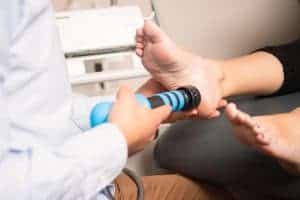
- Extracorporeal Shock Wave Therapy (ESWT)
- Ultrasound-guided Cortisone injection
- Platelet-rich plasma injections (PRP)
- Surgery is always a last resort
Some football players have gone to drastic measures, with stories of jumping off tables to tear the fascia completely so they can return to sport again and play with less pain.
It’s important to find the true cause of your plantar fasciitis, otherwise the problem will return later.
How long does it take for plantar fasciitis to heal?
The healing time for plantar fasciitis varies for each individual. If treated correctly and promptly, plantar fasciitis can resolve very quickly within weeks. If left untreated for many months or years, plantar fasciitis will usually progress and become more resistant to treatment. This means it will take longer to respond to treatment and usually require more intensive treatment.
Over the last 30 years of clinical practice, we’ve seen very acute cases of plantar fasciitis heal within a few weeks with just some simple strapping, loading adjustment and exercises. We’ve also seen very severe cases with significant bone spurring all along the sole of the foot which had formed over a six year period. This type of problem required over 12 months of intensive treatment to stabilise. There is no guarantee that the right amount of spurring and thickening will lead to a pain free foot. This is why we suggest an early diagnosis and treatment to achieve the best possible pain relief and outcome and to reduce the likelihood of needing pain medication or surgery.
You can reduce pain in much less time if you receive the right treatment promptly.
Other Frequently Asked Questions about Plantar Fasciitis…
Should I wear special shoes or orthotics for plantar fasciitis?
Wearing shoes with good support, cushioning and proper heel stability can help with easing plantar fasciitis pain. Additionally, custom orthotics or shoe inserts prescribed by a podiatrist can provide specific additional support and help to relieve overuse and excessive loading on the plantar fascia which ultimately helps to promote healing.
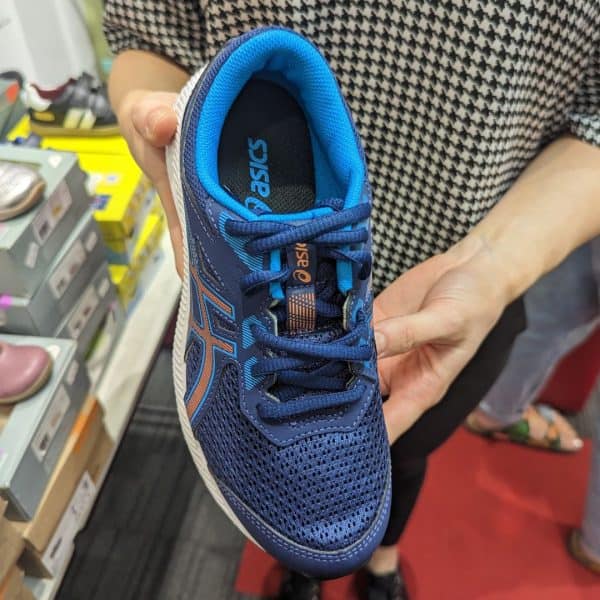
Can plantar fasciitis recurrence occur after treatment?
Yes, plantar fasciitis can return following treatment, especially if the underlying causes or risk factors are not addressed. It’s important to continue with preventive measures even after symptoms have resolved to ensure any recurrence is prevented.
Is it advisable to continue physical activities or sports with plantar fasciitis?
It is generally recommended to modify or temporarily avoid activities or sports that aggravate plantar fasciitis. It’s best to consult with your podiatrist for advice on appropriate activity levels.
Is plantar fasciitis the same as a heel spur?
No, heel spurs and plantar fasciitis are two separate problems, however, the term ‘heel spur’ is often used to describe plantar fasciitis. More information about heel spurs can be found on our heel spur webpage but, in simple terms, plantar fasciitis is a soft tissue injury whereas a heel spur is a bony growth (also known as an osteophyte) usually at the bottom of the heel or at the rear of the heel bone.
Is plantar fasciitis the same as arthritis?
No. Plantar fasciitis is often the result of overuse, however, plantar fasciitis can occur in conjunction with some forms of arthritis.
When should I see a doctor for plantar fasciitis?
There are many causes of heel pain which can often feel very similar to plantar fasciitis. Some causes are more serious than others. If pain occurs and persists for longer than a week, consult an experienced podiatrist before the condition becomes chronic.
Looking for an Adelaide Podiatrist for plantar fasciitis heel pain treatment?
BOOK ONLINE for an Initial Low or No Gap* Assessment
by experienced Adelaide Podiatrists or
Call 8362 5900 to schedule a Low or No Gap* examination to see if we can help.
Conclusion
People with plantar fasciitis experience heel pain in the morning or after rest. It’s common, and the podiatrists at Posture Podiatry are experts dedicated to helping people with plantar fasciitis.
There are many things you can do to help, so have it checked properly and promptly by an experienced podiatrist who can help you choose the right treatment plan for your specific needs.
Where Can I Get Help for Plantar Fasciitis?
The big question is: “Should you see a GP, a Physiotherapist or a Podiatrist for plantar fasciitis heel pain?”
Just like your dentist specialises in teeth and oral problems, podiatrists specialise in feet and heel pain problems. There are times when Physiotherapists and General Practitioners can work wonders for many problems but your best first contact is a podiatrist experienced in the treatment of chronic plantar fasciitis. Fortunately, the Adelaide podiatrists at Posture Podiatry have over 50 years of combined experience in the treatment of plantar fasciitis and associated heel pain. We see the problem everyday and know the best way to obtain the fastest, most permanent relief.
Just like your dentist specialises in teeth and oral problems, podiatrists specialise in feet and heel pain problems. The podiatrists at Posture Podiatry have 40+ years of combined experience in heel pain treatment. Share on XYou can always BOOK ONLINE for an Initial Low Gap or Gap Free* Assessment by our experienced Adelaide Podiatrists or Call 8362 5900 to schedule a Gap Free* examination to see if we can help.
We’ll help you find the right solution to alleviate your pain.
BOOK ONLINE for an Initial Low or No Gap* Assessment
by experienced Adelaide Podiatrists or
Call 8362 5900 to schedule a Low or No Gap* examination to see if we can help.
Sources:
